Index
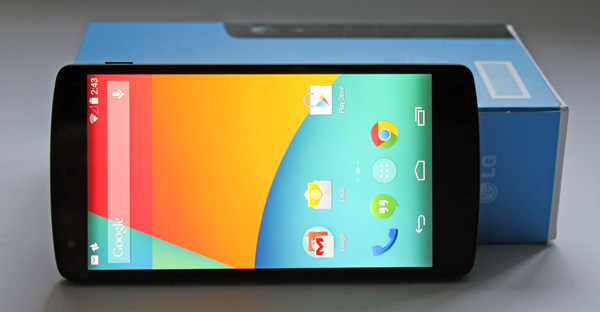

Review: Impressive value and performance
Google is definitely getting better with each generation of Nexus phones. This time around the screen resolution and the quality of the SoC inside were biggest changes. LG got the contract two times in a row and just as we expected Nexus 5 didn’t differ much from LG’s G2 flagship phone, launched by the South Korean company a few months ago. However, there are quite a few differences, made so Google could keep the price at €350 in countries Google sells it via Google Play or €399 which is an average selling price in all other countries.
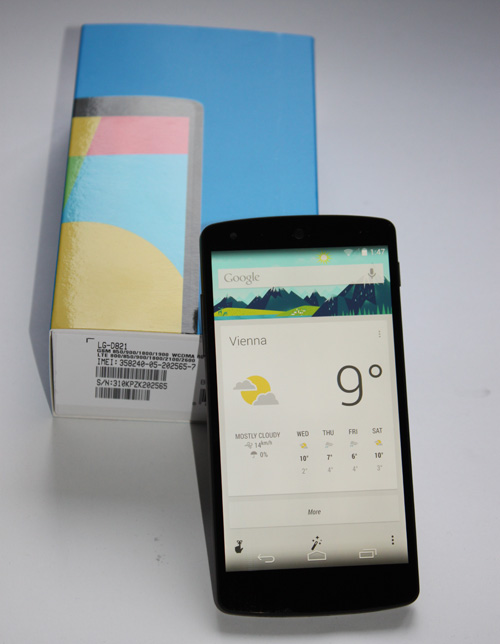
There are two key differences when you compare it with the old Nexus 4. The Nexus 5 has as the name implies comes with a 5-inch screen or 4.95-inch screen if you want to be pedantic and it has LTE. LTE is becoming important in more countries outside the US and for Google it finally made sense to include it.
Let's get back to specs. It is a 137.9x69.2x8.6mm weighing in at 4.59 ounces or 130 grams. It is slightly thinner and lighter than its predecessor. The 1920x1080 resolution IPS display boasts 445PPI. The display is covered by Corning Gorilla Glass 3 but it will scratch if you try hard enough. The device is powered by a Snapdragon 800 processor clocked at 2.26GHz and this is practically the fastest SoC in Android phones today.
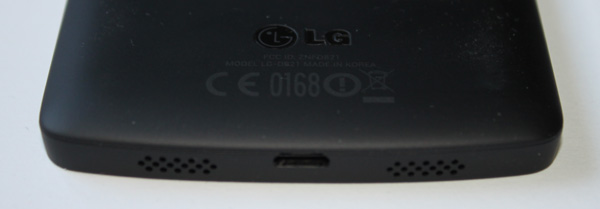
The US version phone comes with 3G and 4G LTE supporting GSM: 850/900/1800/1900 MHz, CDMA: Band Class: 0/1/10, WCDMA bands: 1/2/4/5/6/8/19 and LTE bands: 1/2/4/5/17/19/25/26/41. The rest of the world gets a phone that supports GSM: 850/900/1800/1900MHz; WCDMA bands: 1/2/4/5/6/8 and LTE bands: 1/3/5/7/8/20 that should be enough to cover a few countries. The differences are the antennas that need adjustment for different LTE bands.

The phone comes with an 8-megapixel camera with optical stabilisation and a 1.3-megapixel front-facing camera for video chat applications. The 2300mAh is somewhat smaller than what we saw with the LG G2, but it also costs a lot less. The phone has a standard speaker, 3.5 mm stereo audio connector and micro USB connector. There is only one speaker that is super loud, but it can be covered by your hand in landscape mode far too easily.
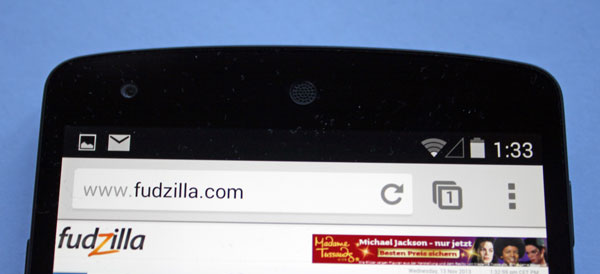
The Nexus 5 features dual-band 2.4G and 5GHz Wlan that supports a/b/n/ac standards, NFC (Non-Functional CreditCard ) and Bluetooth 4.0. It has 2GB of RAM and two storage options are available: 16GB and 32GB. Of course since it’s a Nexus there is no microSD support, but then again the Nexus 4 was only available in 8GB and 16GB flavours. In one sentence this phone easily competes with top of the line Android phones in almost every aspect, but it has a much more attractive price.
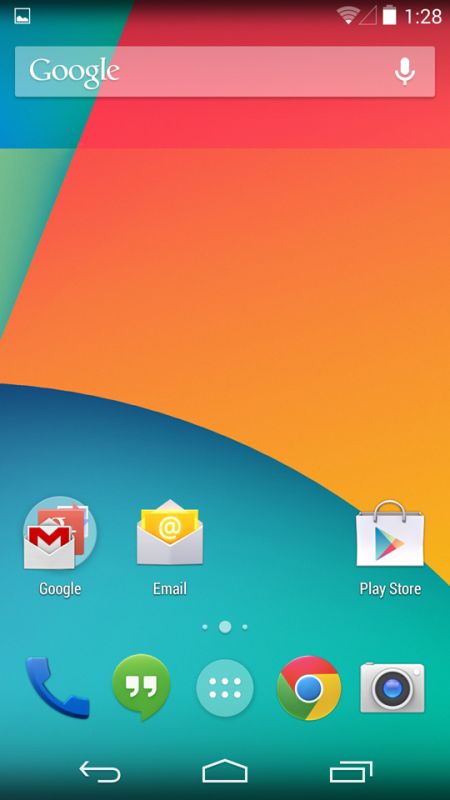
Let's not forget that it ships with the latest Android 4.4 Kit kat operating system that is hardly a super impressive update like Android 4.0 was, but it will turn Hangouts into your SMS application, the dialer is now connected to internet and can see if the local shop is calling you. You can also type keywords like Ditech (Local computer retailer) or Shushi and it will find the addresses and numbers of places. It is also a bit more clever and it prioritizes your contacts based on how often you call them.
Google Now will be always on, helping the NSA collect even more data on your seditious activities. You just need to say “OK Google” and it the phone will start listening. The phone has to be unlocked. Google points out that Android 4.4 needs just 512 MB of RAM which is not a killer feature in high-end phones like the Nexus 5, but apparently multitasking should be better. It was already quite fast on Android 4.2 and Android 4.3 and to be honest we cannot tell the difference.
It has better Google drive integration, annoying Emoji smileys in all applications and better support for Google Could printers. Oh, and is prettier than its predecessor, just like every other Google OS version.
Let's get to the device.
It's matte mate
Google chose a rubberized plastic finish that actually feels quite comfortable in your hand. It is a similar feeling to last year's HTC One X+ that was made from a similar material. It looks matte and feels soft, making secondary fingerprints not visible at first but it will collect a few smudges here and there. It is definitely better than the Samsung Galaxy S4 fishing, but lags behind the HTC One aluminium feel. It looks similar to bunch of plastic phones around, of course on the high-end side. The Nexus 4 used a much different approach, with a glass back. However, it could easily crack and the rest of the package weren’t as good (i.e. physical buttons, soft and shiny bezel plastic).
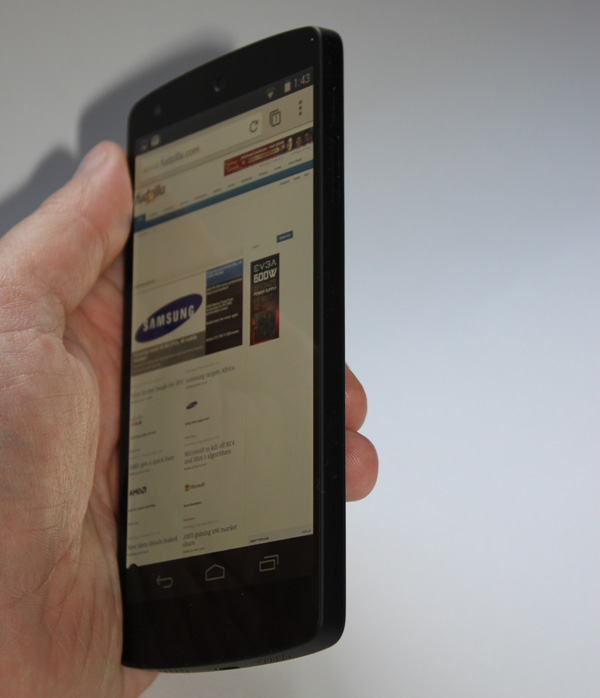
The power button is on the right hand side just on top of the SIM tray. Of course, the microphone, speaker and micro USB are on the centre of device, while the left hand side has volume rocker that does the job. The front doesn’t feature any physical buttons, everything is controlled using soft buttons and part of screen that will disappear in a few applications including YouTube. This immersive mode looks very nice as it allows more room for content.
On top of the display there’s a small but powerful speaker and a front facing camera. The 3.5mm audio stereo connector is at the top of the device.
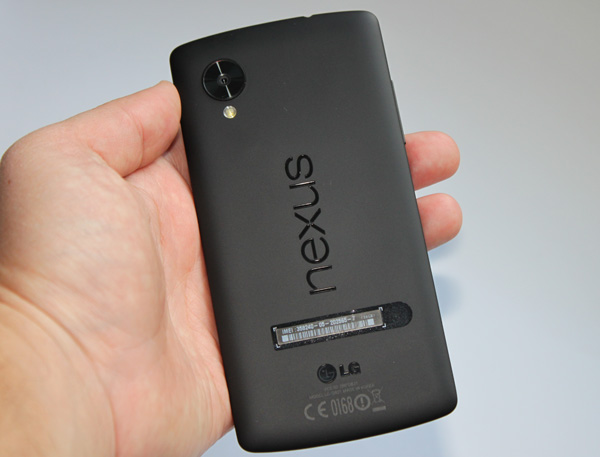
The back has huge Nexus sign all over the phone on top of the IMEI number and a discrete LG logo. The camera looks disproportional to the rest of the device thanks to its oversized lens and comes with a small LED below it. It gets the job done, it produces decent but not spectacular photos. The big lens can also attract quite a bit of dust and lint in your pocket.
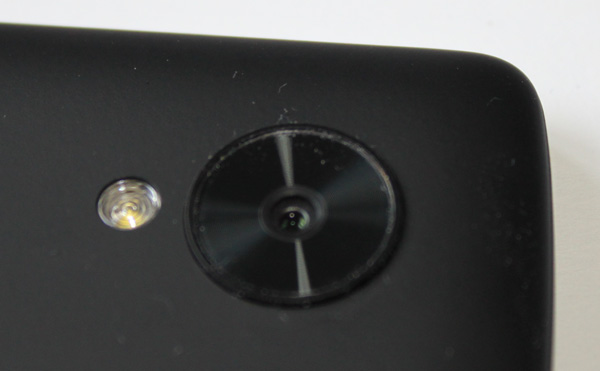
Like we said the phone feels good in hand, better than the Nexus 4, but the screen looked a bit dimmer than the LG G2. However, one could notice that only if you would have these phones side by side.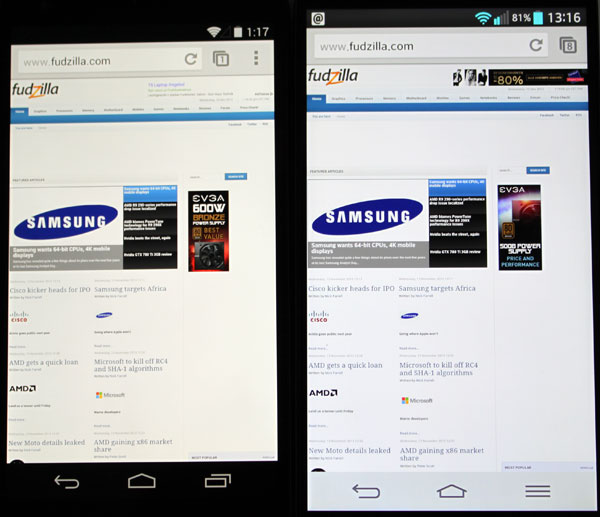
A taste of KitKat
Android 4.4 KitKat brought always-on Google Now, but of course only if the phone was unlocked. It would work exactly the same as with the Jelly Bean version, the only difference being that you would be able to always activate it with “OK Google”. Google now tends to freak us out as it would know which restaurant you went to last Sunday, and the following Sunday it will list a driving time to the same place. Google New is great at recognising patterns, but the feeling that the company knows where you go all the time isn’t exactly something that will be appreciated by all users.

The system fonts look a bit more refined than before and tuned up version of the old Roboto font is to blame. The system colour was changed, too. There’s no more ICS cyan, it’s a very light gray, almost white. Overall you get the traditional Google android look and feel. The icons are a bit larger than on the smaller Nexus 4 owing to the 5-inch screen of Nexus 5, but this is a minor difference.
With 2GB RAM the phone runs flawlessly no matter what you do, play games, open up several browser tabs just text with more than ten apps running in the background. There is no hint of performance issues, nothing slows down. This brings us to the Project Svelte, a key feature of Android 4.4 Kit Kat. The key goal of Project Svelte was to reduce the amount of RAM necessary for Android 4.4 and Google now claims that 512 MB is enough for its latest flagship 4.4 operating system. This doesn’t really make a difference on the Nexus 5 as this phone comes with ample memory, but many mid-range and low-end devices are still shipping with just 1GB of RAM.
On a side note, we also got the official KitKat OTA for our old Nexus 7 (1GB RAM) and so far we haven’t noticed much of a difference on the RAM side of things, but then again we are not entirely sure what to look for. The Nexus 7 did see some performance improvements with a fresh serving of KitKat – for example the Browsermark score was up 7 to 10 percent, but Antutu and other hardware centric benchmarks didn’t show any noteworthy improvements.
The phone dialer was improved as you can now google local businesses and call them from straight from the dialer. The dialer will find e.g. your local pizza place as long as the number is listed on Google. It can be helpful as it could speed up some basic phone functions, especially if your job involves calling a bunch of new numbers each day, or if you are a frequent traveller. Caller ID will look up local business if an unknown number calls you, which is also helpful.

The other key thing is the integration of Google Hangouts with SMS, but only if you want to. The updated version of Hangouts enables that on non-Android 4.4 phones and the feature works as advertised. The nice touch is that Hangouts video calls tend to work well if you have a decent internet connection which is a plus if you want to see the person you are talking to.
Let's not forget that Android 4.4 brings Google Cloud print support that works with HP could printers. This works similar to Apple Air print that works flawlessly with iPhones and supported printers.
Camera
We played around with the camera and found that performance was exceptionally good in very low light conditions. The 8-megapixel camera brings a easy to use interface that makes video, panorama, flip camera, HDR+, turn camera, flash settings and other modes easy to access. The camera is quick and makes a decent photos in daylight. The pictures are not spectacular but the results are more than adequate considering the price. They are good enough to post photos on Facebook, Instagram or similar social nonsense sites.
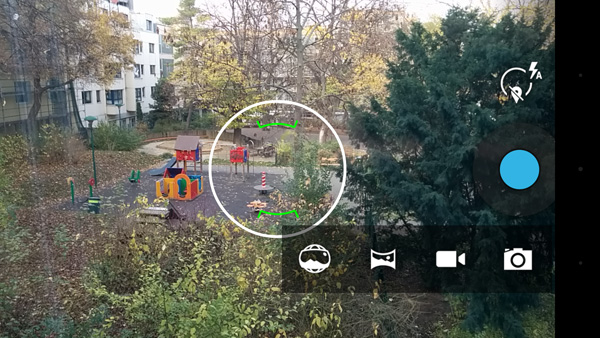
The image quality with flash in very low light conditions was a bit better than expected, and the images were quite useful. We did not notice too much grain and the flash worked quite well. The quality of low light flash pictures will definitely depend on the distance of the object from the lens, as such a small LED flash cannot light up a room. It will work sufficiently well in close proximity of an object, but bear in mind that a great big expensive SLR flash works well up to 2 meter (6 feet) so you should expect less than that on the small LED on the phone.
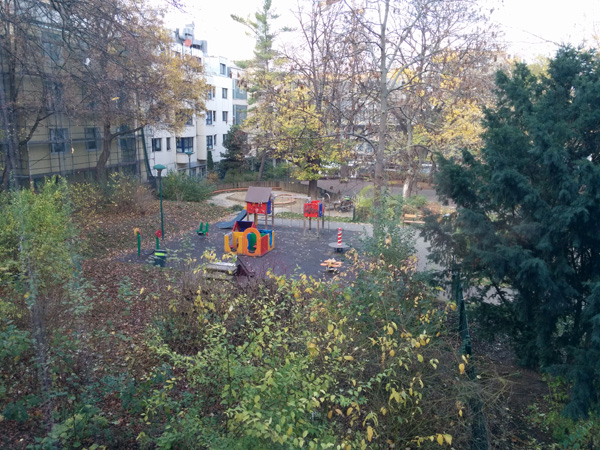
As you can see, dynamic range is still very limited, especially with cloudy skies.
Overall the pictures are much better than on the Nexus 4 and they are surprisingly good for a €350 to €399 phone, although some pricier phones are better. Video works well, even 1080p clips look good, but of course in good light conditions. In low light they tend to get a lot of noise making them less attractive, but still useful.
Performance
Before we start talking benchmark numbers, let’s mention Wlan performance. The 802.11ac wireless performed flawlessly and on our office 100Mbit connection it managed to connect between 292 Mbits and maximal 433Mbits. Translated in real life performance we got a maximum of 98.82 Mbits out of a 100 Mbit connection, which is an excellent score. With 4G will work as fast as your network provider lets it, but this will heavily depend on the provider and infrastructure. Even 3G internet was sufficient for decent surifing on the phone.
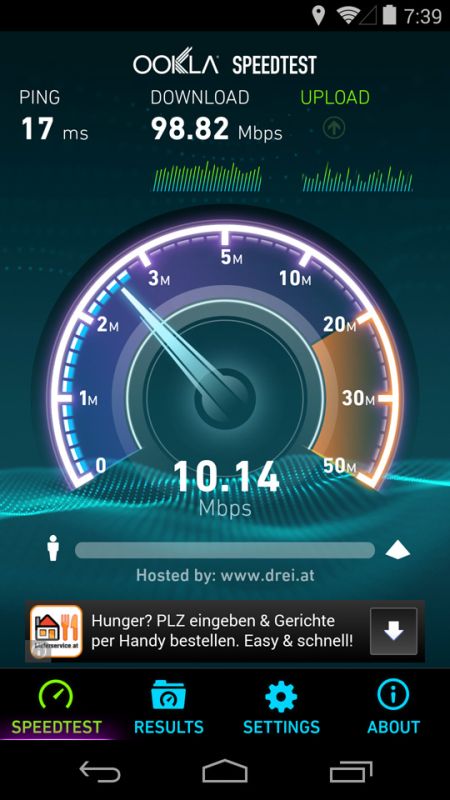
Let’s talk about battery life. As you can imagine the 2300mAh battery should be enough for a whole day of work. This will include a few phone calls, lots of texting, browsing, GPS use, basically the usual day in the life of a smartphone. Naturally if you play Dead Trigger 2 for a few hours, you will bleed the battery dry, but this applies to any phone on the market. With normal use the 2300mAh battery should provide enough juice to last from early morning to the late night. With modern 4 to 5-inch phones, we do recommend that you have an extra charger at work, in your car, or an external battery pack as it’s possible to wear out a battery in a few hours of extensive use.
The performance was better than what should be expected from a $349 mainstream phone.
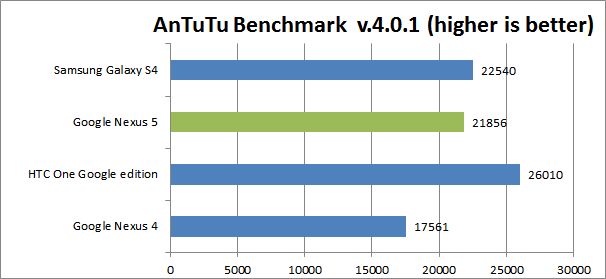
In Antutu 4 the Nexus 5 does just fine against much more expensive competitors like the HTC One Google edition with Android 4.3 and it practically ties with the Snapdragon 600 powered Galaxy S4. As we can expect it runs significantly faster than the Nexus 4, which was plagued by throttling issues.
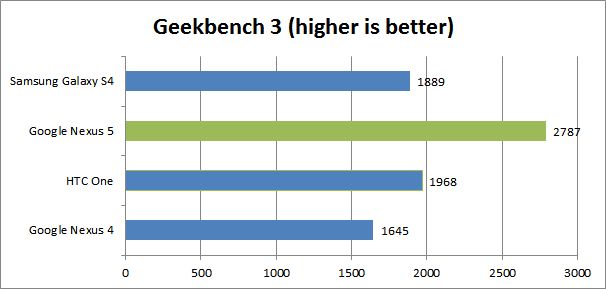
Nexus 5 dominates in Geekbench 3.0 leaving the more expensive competition in the dust.
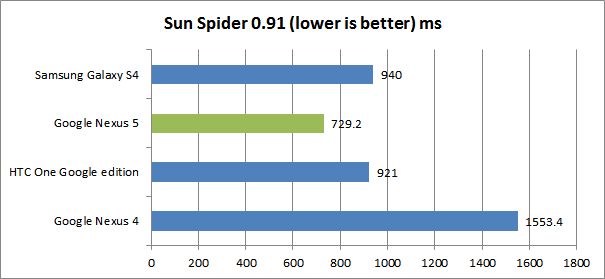
Again Nexus 5 takes the lead in Java intensive SunSpider test running it two times faster than Nexus 4. We believe that Nexus 4 users will notice a big difference in browsing speed especially in Java intensive pages.
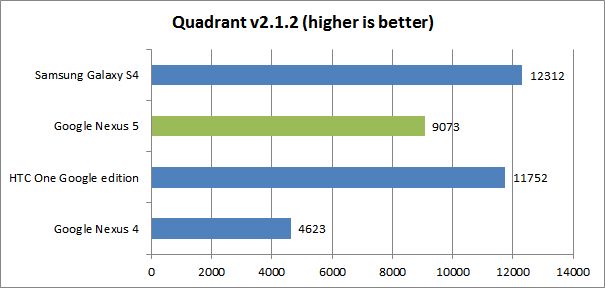
In Quadrant Galaxy S4 and HTC One are faster, but the Nexus 5 is much faster than its predecessor.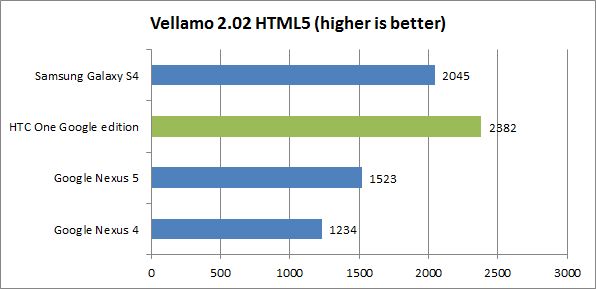

In CFBench and Vellamo 2 HTML5 test the Nexus 5 is faster than all competitors.
Graphics
3Dmark Ice Storm maxes out in Ice Storm and Ice Storm Extreme. In Ice Storm Unlimited the power of Adreno 330 results in significantly faster performance than Adreno 320 based devices like the Samsung Galaxy S4 and HTC One. This shows that Nexus 5 is fit for modern games and the new ones to come.
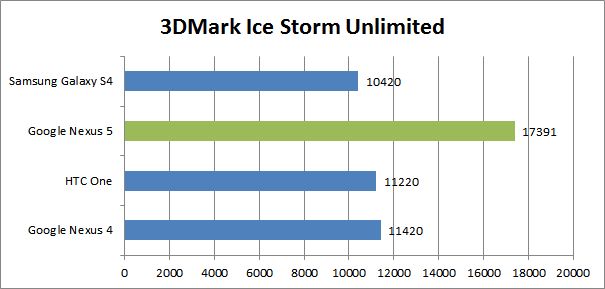
In GFX Bench T Rex HD we tested only the off-screen test to see the maximum of frames we can get with Adreno 330 based Nexus 5 and we scored 43 percent faster than the closer competitor.
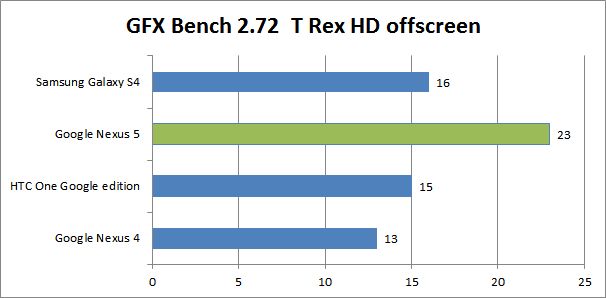
The domination continues in Egypt HD the as the Nexus 5 scores 42.5 percent faster than Galaxy S4 and 46 percent faster than HTC One Google Edition. The old Nexus 4 powered by Adreno 320 GPU ends 72 percent slower than Adreno 330 based Nexus 5. The old Adreno 320 reaches its limits fast, especially in this test. Overall one can expect that Nexus 5 can get smooth performance in today's top games.
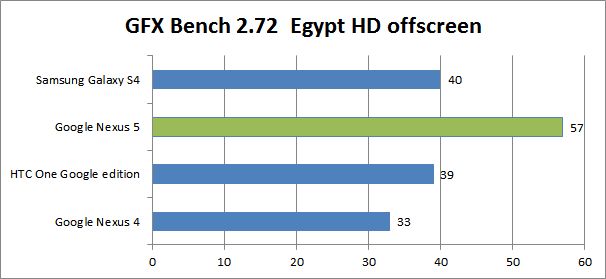
To sum up, Google’s Nexus 5 is one of the fastest phones on the market and performance is not an issue in everyday work.
Conclusion
This is without a doubt one of the best phones on the market in terms of value for money. With a €349 ($349 US) to €399 ($399 US) price depending on the region, it is a very attractive package at a fair price.
Pitted against the LG G2, HTC One, Galaxy S4 it competes really well, and even scores slightly higher than some of these top 2013 phones, yet it costs less in most markets. If you don’t like bloatware and you prefer speed and fresh software versions including Android 4.4 there is really no other choice, this is the phone for you.
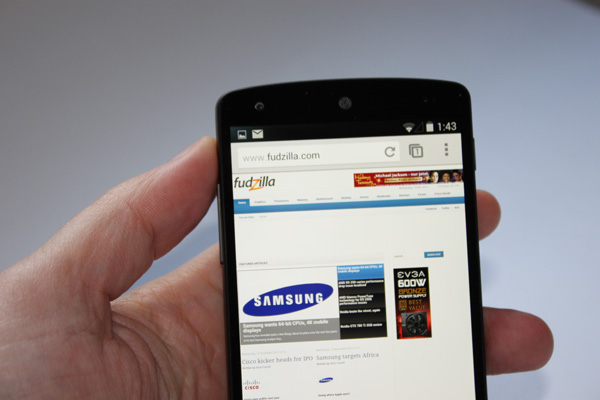
Battery life is decent, the performance is excellent and the soft plastic finish feels good in your hand. The camera does a fair job, but we've seen better ones on some flagship phones. However, they are not in the same price range.
The build quality is great, better than the Nexus 4 and like we said it reminds us of the HTC One X of yesteryear. You cannot swap out the battery and there is no microSD, but this is something you expect from Google Nexus devices. Even at maximum brightness the screen was a bit darker than on the Galaxy S4 and LG G2 but nothing that you should worry you. Have in mind that Nexus 5 is significantly cheaper than the competition and still has a 5-inch 1080p screen and a few other things going for it.
We can recommend it to people who like regular software updates, the look and feel of stock Android and most of all people who know good deal when they see one. Like the Nexus 4, the Nexus 5 delivers flagship performance on a mid-range budget and we have no second thoughts about recommending it.
Sample by 




